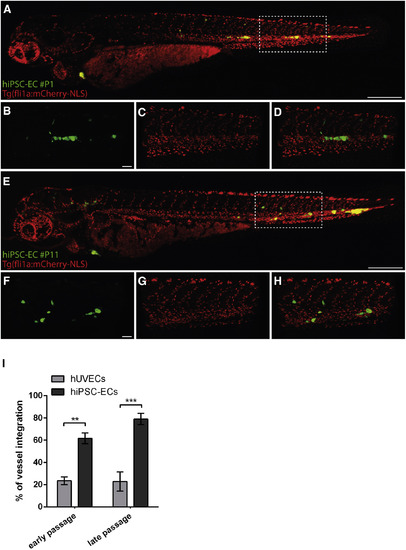- Title
-
Differentiation of Human Pluripotent Stem Cells into Functional Endothelial Cells in Scalable Suspension Culture
- Authors
- Olmer, R., Engels, L., Usman, A., Menke, S., Malik, M.N.H., Pessler, F., Göhring, G., Bornhorst, D., Bolten, S., Abdelilah-Seyfried, S., Scheper, T., Kempf, H., Zweigerdt, R., Martin, U.
- Source
- Full text @ Stem Cell Reports
|
Vascular Competence of Early and Late hiPSC-Derived EC Passages in a Zebrafish Xenograft Model Early (P1) passage hiPSC-ECs (green, hCBiPSCAGeGFP) within the embryonic zebrafish vasculature [marked by Tg(fli1a:mCherry-NLS)ubs10, red)] 1 day after transplantation (A). Scale bar, 300 μm. Details of vessels with P1 hiPSC-EC (green) integration into the Tg(fli1a:mCherry-NLS)ubs10 transgenic embryonic zebrafish vasculature (red) (B–D). Scale bar, 50 μm. Late (P11) passage hiPSC-ECs (green) within the Tg(fli1a:mCherry-NLS)ubs10 transgenic embryonic zebrafish vasculature (red) 1 day after transplantation (E). Scale bar, 300 μm. Details of vessel with P11 hiPSC-EC (green) integration into the Tg(fli1a:mCherry-NLS)ubs10 transgenic embryonic zebrafish vasculature (red) (F–H). Scale bar, 50 μm. Quantification of integration rates of early and late hiPSC-ECs compared with early (P1, P4, and P5) and late (P14) hUVECs into the zebrafish embryonic vasculature 1 day after transplantation. Integration rates into the zebrafish vasculature were 61.9% (n = 83/134 embryos) for early hiPSC-ECs and 78.3% (n = 112/143 embryos) for late hiPSC-ECs. ∗∗p ≤ 0.01, ∗∗∗p ≤ 0.001 (I). |

